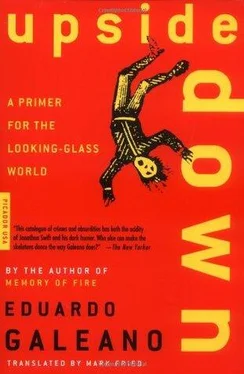Until 1991, a company called CMS made mines for the U.S. Army. After the Gulf war it changed tack and has been making $160 million a year in de-mining ever since. CMS belongs to the German consortium Daimler-Benz, which makes missiles with the same enthusiasm that it makes cars, and it continues making mines through another of its affiliates, a company called Messerschmitt-Bölkow-Blohm.
Also traveling the road to redemption is British Aerospace: one of its companies, Royal Ordnance, signed a $90 million contract to remove mines from Kuwait, placed there, coincidentally, by Royal Ordnance. Competing in this selfless task is a French company, Sofremi, which will earn $110 million de-mining Kuwait, while continuing to export weapons for wars throughout the world.
One of the angels carrying out this humanitarian mission on earth with the greatest fervor is a South African specialist named Vernon Joynt, who has spent his life designing antipersonnel mines and other deadly contraptions. This man is in charge of clearing Mozambique and Angola of the thousands of mines he invented for the racist army of South Africa. His task is sponsored by the United Nations.


CRIME AND REWARD
General Augusto Pinochet raped, tortured, murdered, robbed, and lied.
He violated the constitution he had pledged to respect. He was the strongman of a dictatorship that tortured and murdered thousands of Chileans. He sent tanks into the streets to discourage the curiosity of those who wanted to investigate his crimes. And he lied every time he opened his mouth to talk about these things.
Once the dictatorship was over, Pinochet stayed on as head of the army. And in 1998, when he was to retire, he stepped onto the country’s civilian stage. As I write these lines, he has, by his own order, become a senator for life. Protest has erupted in the streets, but the buoyant general, deaf to anything but the military hymn praising his achievements, proceeds to take his seat in the Senate. He has plenty of reason to turn a deaf ear: after all, the day of the 1973 coup d’état that ended Chile’s democracy, September 11, was celebrated as a national holiday for a quarter of a century, and September 11 is still the name of one of downtown Santiago’s main thoroughfares.
CRIME AND PUNISHMENT
In the middle of 1978, while Argentina’s soccer team was hosting and winning the World Cup, the country’s military dictatorship was busy throwing prisoners into the ocean alive. The planes bearing them took off from Aeroparque airport, a stone’s throw from the stadium where the sports event was under way.

Not many people are born with a conscience, that inconvenient gland that haunts your nights and disturbs your sleep worse than the mosquitoes of summer. But sometimes it happens. When Captain Adolfo Scilingo told his superiors he couldn’t sleep without pills or drink, they recommended therapy. At the beginning of 1995, Captain Scilingo decided to make a public confession: he said he had thrown thirty people into the sea. Over the course of two years, he added, the Argentine Navy had thrown between fifteen hundred and two thousand political prisoners to the sharks.
After his confession, Scilingo was imprisoned. Not for having murdered thirty people but for having passed a bad check.
CRIME AND SILENCE
On September 20, 1996, the U.S. Defense Department also made a public confession. The story earned little or no coverage from the major news media. That day, the highest military authorities acknowledged that they had made “a mistake”: from 1982 to 1991, they had trained Latin American military officers in the arts of threat, extortion, torture, kidnapping, and murder at the School of the Americas in Fort Benning, Georgia, and at the Southern Command in Panama. The “mistake” lasted a decade, but they didn’t say how many Latin American officers received the mistaken training or what the consequences had been.

In reality, the Pentagon’s classes for future dictators, torturers, and criminals have been denounced a thousand times in the past half century. Their Latin American students numbered some sixty thousand. Many of these same students became dictators or public executioners and left a permanent bloodstain south of the Rio Grande. To cite just one country, El Salvador, and to offer no more than a few examples from an endless list, nearly all the officers responsible for the assassinations of the archbishop, Monsignor Oscar Arnulfo Romero, and four U.S. nuns were graduates of the School of the Americas. So were those who carried out the murders of six Jesuit priests riddled with bullets in 1989.
The Pentagon has always refused to collect author’s royalties on the training manuals it finally acknowledged as its own. The confession ought to have been a big story, but few heard it and many fewer were angered: the greatest power in the world, the model, the democracy that inspires the most envy and imitation, acknowledged that its military nurseries had been growing specialists in the violation of human rights.
In 1996, the Pentagon promised to correct the “mistake” with the same seriousness as it had made it. At the beginning of 1998, twenty-two culprits were indeed found guilty and sentenced to six months in jail plus fines. These twenty-two U.S. citizens had committed the atrocity of sneaking into Fort Benning to hold a funeral procession in memory of the victims of the School of the Americas.

CRIME AND ECHOES
In 1995, two Latin American countries, Guatemala and Chile, attracted the attention of the U.S. press, something not at all common.
It came out that a Guatemalan colonel accused of two crimes had for many years been on the CIA payroll. The colonel was charged with the murder of a U.S. citizen and the husband of a U.S. citizen. The press ignored the thousands upon thousands of other crimes committed by the military dictatorships the United States had imposed and removed in Guatemala ever since the day in 1954 when the CIA, with the approval of President Eisenhower, overthrew the democratic government of Jacobo Arbenz. The long cycle of horror reached its peak in the massacres of the 1980s. That’s when soldiers who brought back a pair of ears were given a necklace with a golden oak leaf as a reward. But the victims of that over-forty-year process — the greatest number of deaths in the second half of the twentieth century anywhere in the Americas — were Guatemalans, and to top off their unimportance, most of them were Indians.
While the story of the Guatemalan colonel was breaking, the U.S. papers reported that two high officials of the Pinochet dictatorship had been sentenced to prison in Chile. The assassination of Orlando Letelier constituted an exception to the norm of impunity in Latin America, but one particular detail caught the journalists’ attention: the dictatorship had assassinated Letelier and his U.S. secretary in Washington, D.C. What would have happened if he had been killed in Santiago or any other Latin American city? Of the death of Chilean general Carlos Prats, murdered with his Chilean wife in Buenos Aires in an attack identical to the one that killed Letelier, we’ve still had no news twenty years after the fact.
Читать дальше
















